TVW Engineering Reunion 2012
A reunion of mainly 1960s and 1970s TVW Engineering and Operations folk was held in Kings Park, Perth, at the Botanical Cafe on Friday 2nd March, 2012.
TVW Engineering Reunion 2012
WA TV History
A reunion of mainly 1960s and 1970s TVW Engineering and Operations folk was held in Kings Park, Perth, at the Botanical Cafe on Friday 2nd March, 2012.
It was an opportunity to catch up with former TVW chief engineer John Quicke, who employed a number of those present.
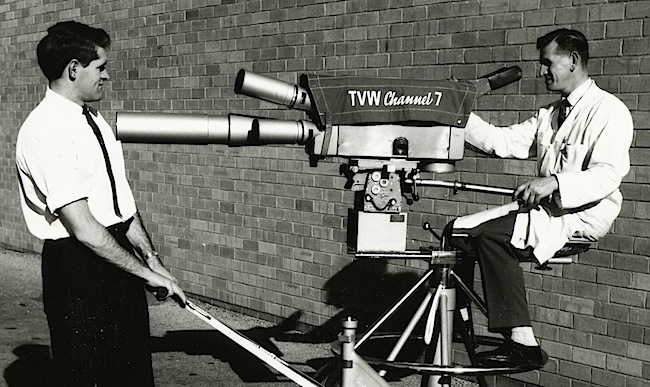
John Quicke and Bert King in 1962
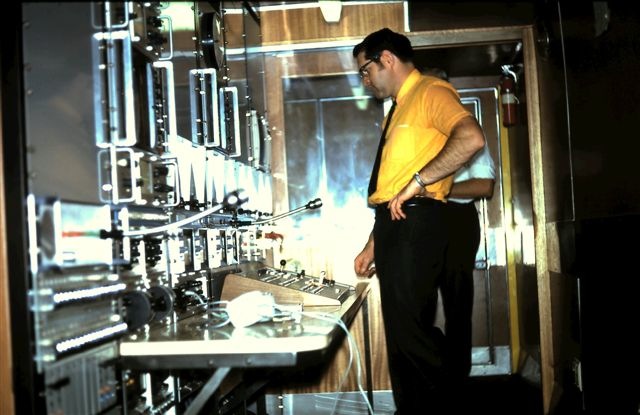
1970, Chief Engineer John Quicke checks progress on installation of TVW’s new OB Van
More than one former chief engineer was there with Kevin Bicknell and Geoff Mortlock also in attendance. Missing was the inaugural chief engineer Graham Davey, followed by Dave Watson and Ted Snell, though much of the time John held a caretaker role until being appointed permanently. It was during John’s watch that many innovations took place. The design of TVW’s first outside broadcast van for the 1962 Commonwealth and Empire Games at Perry Lakes and Beatty Park in Perth, the introduction of videotape, the expansion of facilities to include Studio 1 and a new operational area, newsroom and news studio, the shell for Studio 3, Radio station 6IX’s new studios at Tuart Hill, a tower for OB purposes, an enlarged props area, the first satellite link between WA and the UK, to the initial purchase of colour enabled equipment starting with an RCA TK27 telecine chain and TR70 videotape machine, the upgraded presentation facilities for semi-automation called F.R.E.D. to the building of the Entertainment Centre, and many more events.
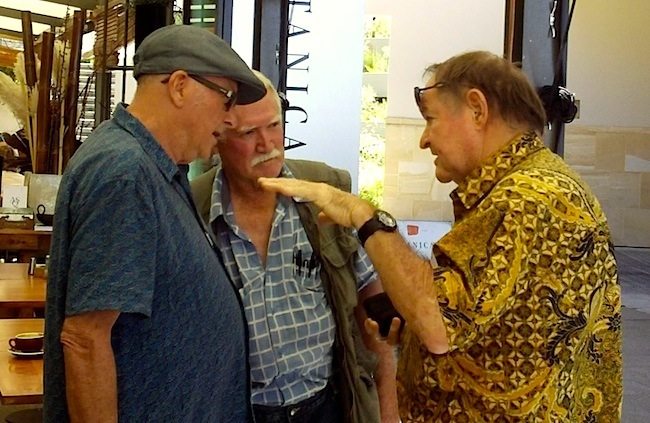
Kerry Cook, Gordon McColl and John Quicke in 2012
There was a good representation of folk from all technical disciplines from studio, outside broadcasting and transmitter installation, maintenance and operations.
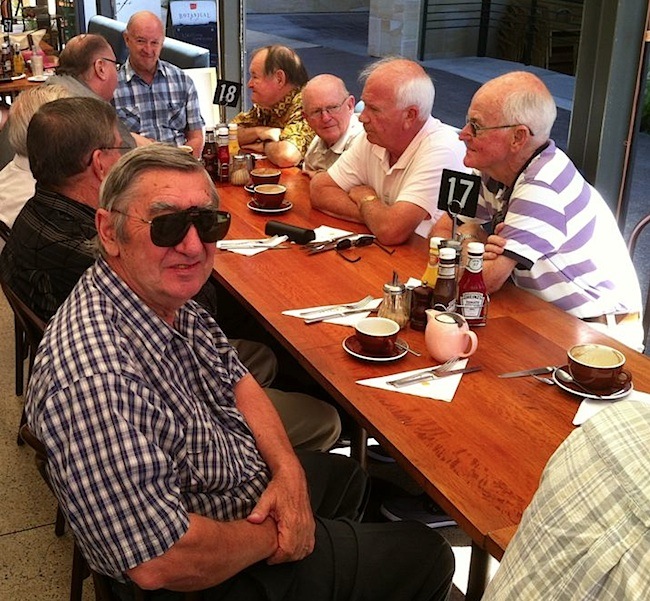
Cedric Woods, Keven Bicknell, Bob Penno, Ken McKay, Allan Smith, John Quicke, Ross McDonald, Kevin Campbell and Peter Hobson in 2012
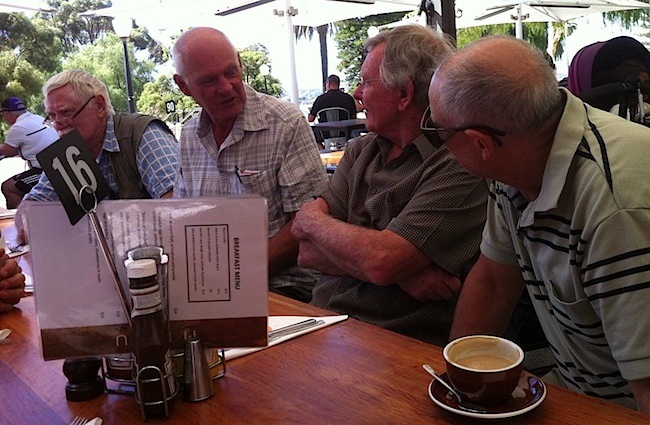
Gordon McColl, Geoff Mortlock, Max Taylor and Hymie Miller in 2012
During the early years, the Engineering Department encompassed a wide range of crafts till 1968 when the Operations Department was created with Kevin Campbell as the first supervision, and later department manager, before rising to be Managing Director of TVW Enterprises. Keith Spice followed in the operations supervision and manager roles before moving onto greater management roles in the company.
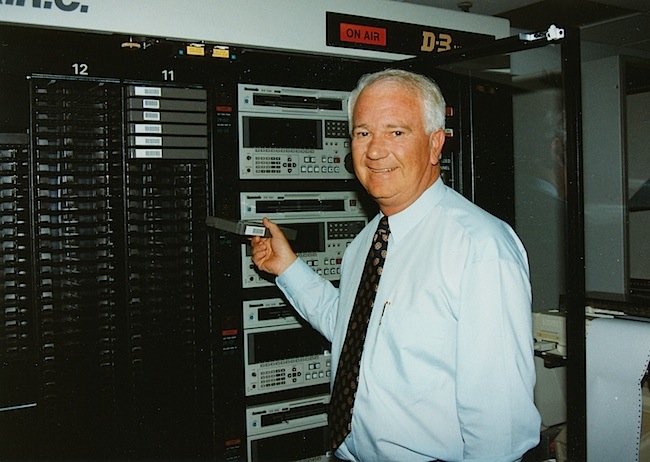
Kevin joined Channel 7 in 1964 and worked continuously with them for 35 years. In that time he was appointed General Manager SAS Channel 7 Adelaide (1977), General Manager Channel 7 Perth (1988), Managing Director Seven Network Sydney (1988) and Managing Director Channel 7 Perth (1991) until his retirement in 1999. Kevin was awarded a Member of the Order of Australia in the 1998 Australia Day Honours List for service to charitable organisations, to television administration and to the community. In 2000 he received the Australian Sports Medal and the Centenary Medal in 2001 for service to business and the community in Western Australia, and in 2003 The Fiona Stanley Medal in recognition of his contribution to child Health in Western Australia.
A number of key staff moved to STW Channel 9 and played pivotal roles in everything from pioneering the stump camera used during cricket matches. Bob Penno, and Cedric Wood were a significant two.
Ross McDonald created TAIMAC which for many years played an important role servicing the WA Turf Club, WA Trotting Association and WA Greyhound Racing Association with on-course television, public address and photo finish facilities. The company also provided broadcast feeds to the television stations to telecast various races. Ross was a Technical Director in the Studios and OBs from 1960 to 1962. After leaving Seven, John Quicke joined Ross at TAIMAC, which interestingly is a combination of the founders names: Ernie Taylor and Ross McDonald. Both TVW pioneers, with Ernie joining STW-9 in 1965.
TVW veteran Phil Salinger is still active and maintains key technical and production roles with Capital Community Radio Inc., Perth’s radio station for seniors located at Wireless Hill. Phil was a Senior Technician who worked at the TVW transmitter and studio from May 1959 to July 1969, and was involved in both the installation of the transmitter and operating it.
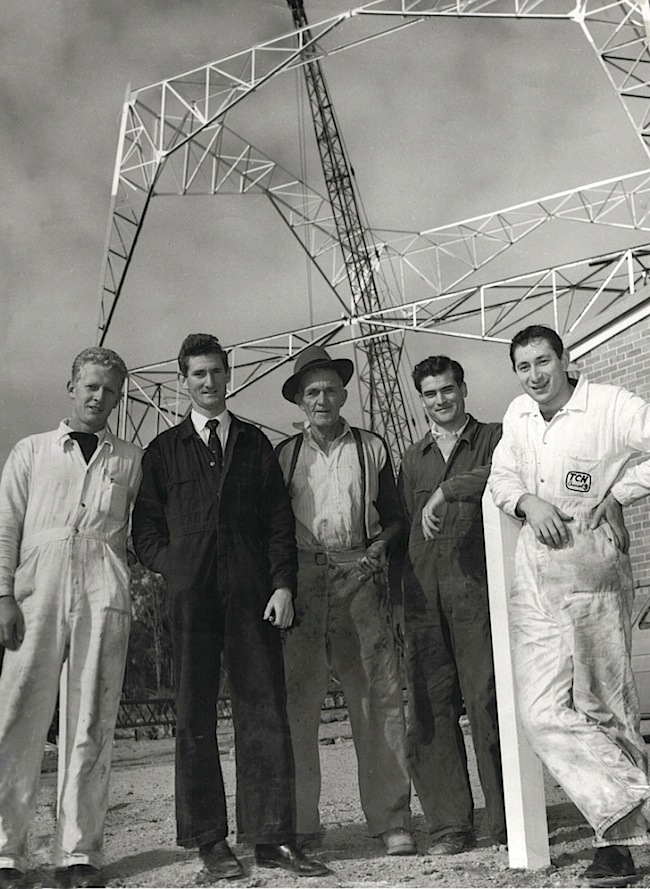
1959 TVW Transmitter construction period
George Baker, John O’Callohan, Les Skipworth, Rex Hogan and Phil Salinger
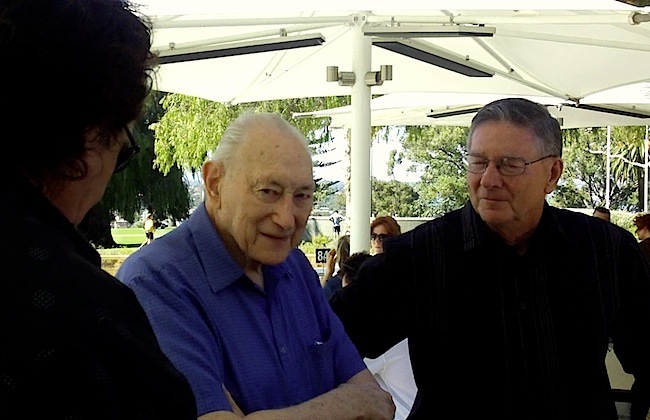
Vic Jones, Phil Salinger and Kevin Bicknell in 2012
Kevin Bicknell was not only a chief engineer of TVW but also known as one of Western Australia’s foremost radio frequency systems engineers and cable infrastructure for broadband and entertainment purposes. Kevin and Jerry Clifton established Broadcast Engineering Services which installed the two Mandurah radio stations and much of the cable requirements for more than 50 suburban locations.
Kevin was one of the VHF Group, who formed in 1955 with the idea of furthering experimentation in amateur radio and in particular in the region of the higher frequencies. They also played a key role in the establishment of the Wireless Hill Telecommunications Museum. Kevin can be found in the centre of the below photo, which represents members during the group’s formative years.
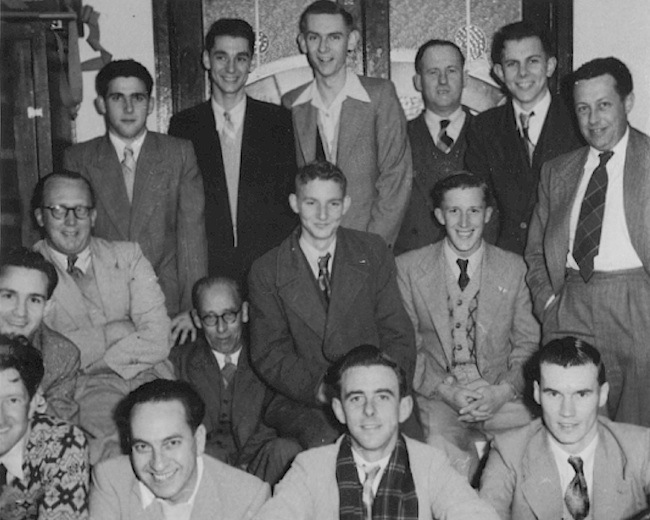
Mid 1950s – VHF Group
Top row: Cec Andrews, Warren Jacobs, Don Graham, Rolo Everingham, Dave Meadowcroft, Frank Chapman
Middle row: Wally Howse, Ralph Deverell, Don Brown, Kevin Bicknell, Len Tate
Front row: Syd Smith, Ron Mould, Denis Cook, Murray Meharry
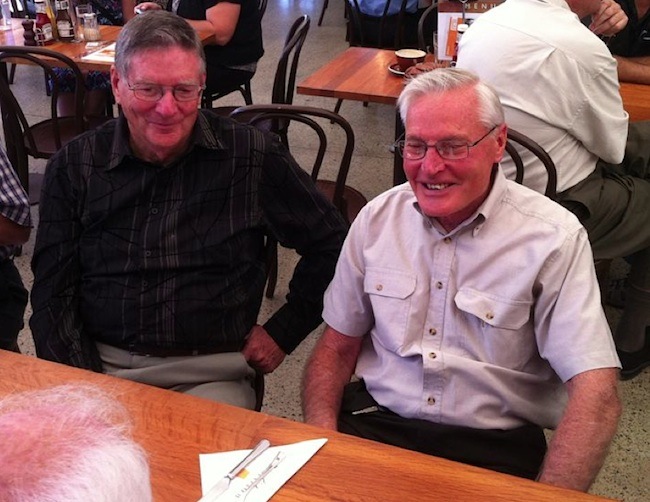
Kevin Bicknell and Bob Penno in 2012
Allan Smith was with the engineering department from 1965 to 2004, and is still occasionally called on by Seven for various projects. Allan points out that the accountants that now control a number of firms have downscaled the support staff who maintain automated systems. Allan now fills that gap providing services on a contract basis. In the early days at Seven, Allan was extremely adept at setting up complicated audio projects. He knew the patch-field inside out and every component in between. He delighted in big projects that involved public address, an outside broadcast and studio elements, such as the ‘Hole in One’ days. One invaluable novelty introduced by Allan was the ‘Taffy Stopper’ which was purpose built for the lion skin clad John Cousins, for the affable but highly audible children’s character had a laugh that would fill the largest auditorium, when unfortunately speaking into a delicate microphone that was under his nose. He could drown out the loudest crescendo of a symphony orchestra, and in doing so bend every VU meter needle and send the program into total distortion, whilst overwhelming any sounds the other cast members made. It was a nightmare for the audio operator. Allan’s wise solution was a compressor than only acted on Taffy’s excesses, thus enabling the rest of the dialogue to be heard.
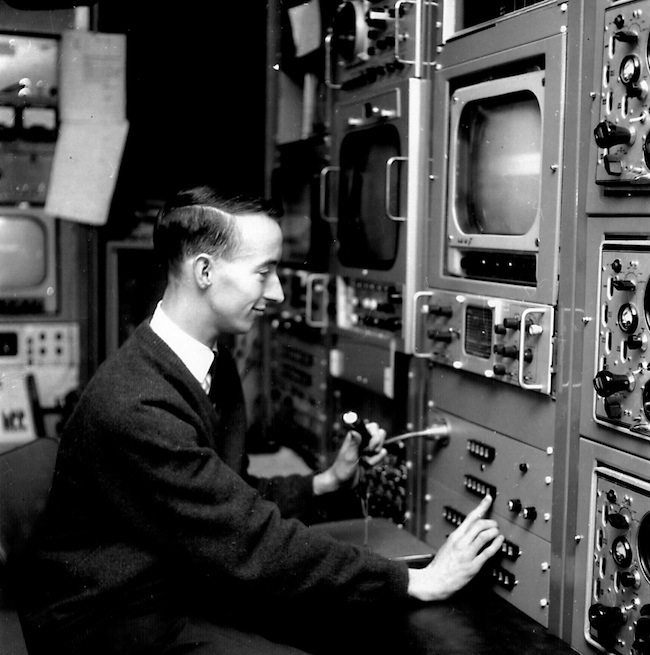
Allan Smith in 1970’s
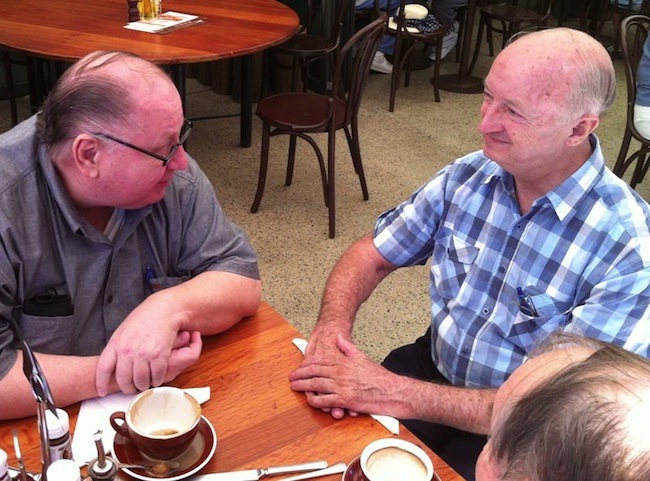
Ken McKay with Allan Smith in 2012
Peter Croft worked through a whole range of eras at Seven from the early labour intensive valve powered days, through the incredible growth that was TVW Enterprises and associated technological developments that made it an autonomous and successful business to the takeover and assets stripping period, and until it is now largely an outpost of the Seven Network. Peter has worked as a technician, presentation controller, videotape and telecine operator, master control supervisor and digital systems supervisor from 1966 to 1999. He is to be thanked for providing us with a great pictorial essay of TVW over the decades in the article: Peter Croft – Evolution of transmission facilities at: http://watvhistory.com/2009/03/peter-croft-evolution-of-transmission-facilities/
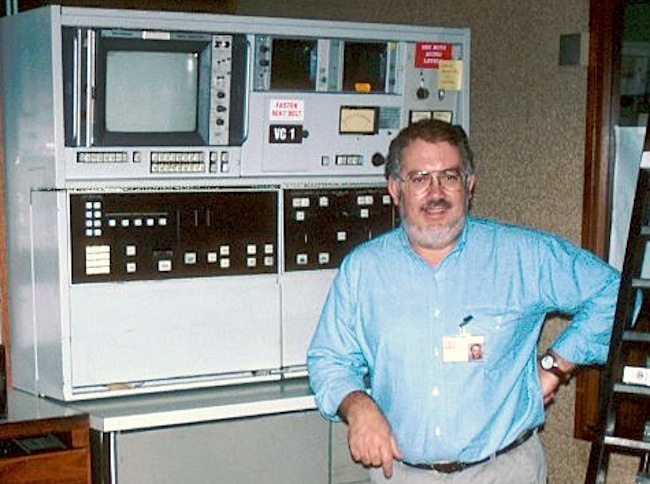
Peter Croft in 1990s
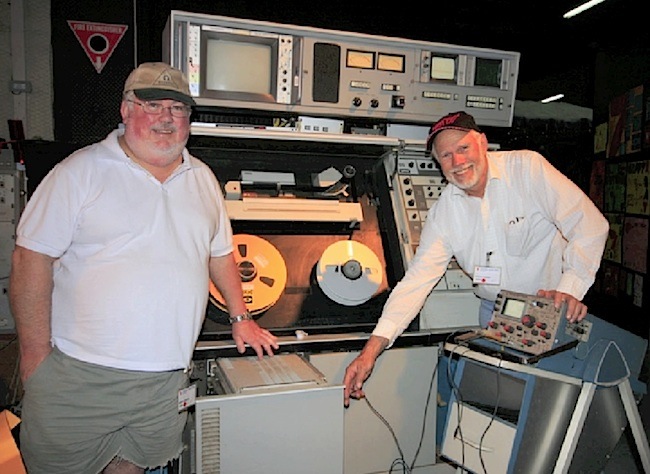
Peter Croft and Peter Partridge prepare equipment for display at the TVW Reunion in 2009
Lindsay Smith worked as an Audio operator from 1961 to 1968, before furthering his career in the electrical field. The story Lindsay Smith – TVW Audio Operator 1961-1968 deals with this period at: http://watvhistory.com/2009/09/lindsay-smith-tvw-audio-operator-1961-1968/
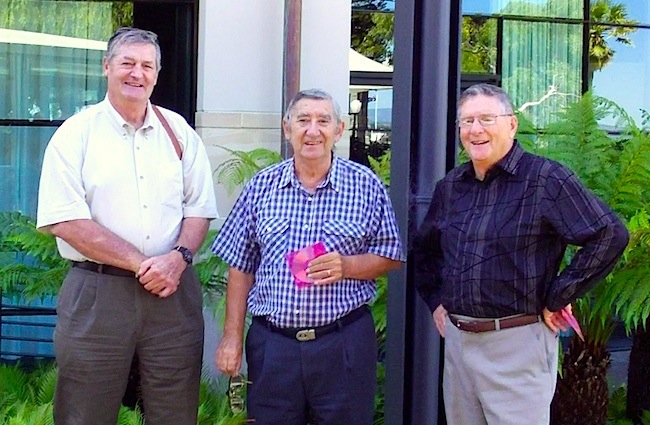
Lindsay was one of a number of TVW folk involved in the outside broadcast which covered the hunt for murderer Brian William Robinson. Others involved included Cedric Woods, Ross McDonald, Vic Jones, Colin Gorey, Don Hanran-Smith, Darcy Farrell, Bob Cribb, Peter Goodall, Paul Kinna and John O’Callaghan, in December 1963. More can be found on this subject in the story Hunt for murderer Brian William Robinson OB at: http://watvhistory.com/2009/10/lindsay-smith-seeks-feedback-on-hunt-for-murderer-brian-william-robinson-ob/

Darcy Farrell, Ross McDonald, Lindsay Smith, Colin Gorey, Cedric Woods, Peter Goodall, Vic Jones and Don Hanran-Smith all attended the TVW Reunion in 2009 with Ross McDonald, Lindsay Smith, Cedric Woods and Vic Jones present at the Engineering gathering in 2012
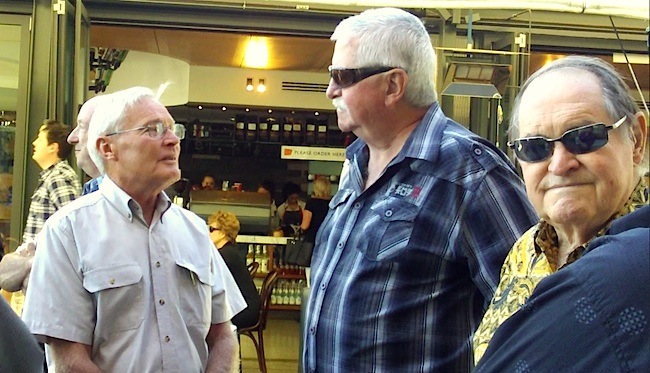
Bob Penno, Keith Spice and John Quicke in 2012
Bob Penno was a technician in studio maintenance, OB’s and at the Bickley transmitter from 1963 to 1965.
Bob and Cedric Woods were both electrical apprentices in the WA Government Railways. Like Cedric and others, Bob also joined STW where he became assistant chief engineer to both Gus Slater and Tom Provan, before becoming chief engineer.
Gordon McColl worked at TVW from 1959 to 1975 doing everything from opening night cameraman, floor manager, presentation coordinator, program director to News studio director and news cine cameraman. Many of the early photos on this web site are courtesy of Gordon, as are a number of recent photos.
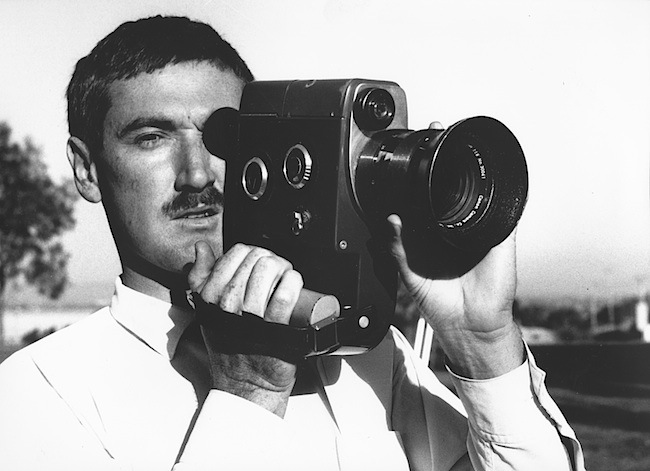
Bert King worked in Engineering at both the studio and Bickley transmitter between 1960 and 1971. Bert played a big role in the early days of outside broadcasting, having installed TVW’s first OB van, which was designed by John Quicke. Bert’s other activities include amateur radio (as applies to many of the early TVW technical staff) and was involved with setting up the Kalamunda community radio station.
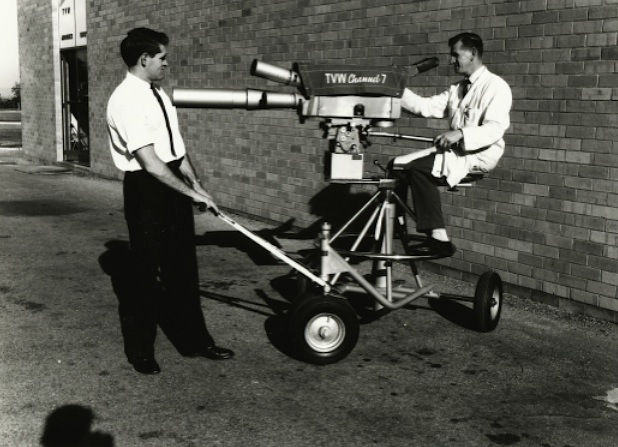
John Quicke and Bert King in 1962
Vic Jones started in TVW Accounts (1960-1961) before making the transition to Engineering (1961-1962) to become a gun Audio man (1962-1966, 1984-1995, 2007-off & on ’till recently). During the 1960s, Vic was in a band called The ‘Thorts’ which made a number of appearances on Club 7 Teen, then directed by Gordon McColl. A show that Vic was often the audio operator for. The band consisted of Ray Van Ross (lead singer), Vic Jones (bass guitar), Les Watling (drums), Nigel Van Ross (rhythm guitar), and Harry Allen (lead guitar). Vic reflects on the early days of Audio and its evolution till now at: http://watvhistory.com/2009/10/vic-jones-tvw-1960-1966-1983-1995-2006-‘till-now-reflects-on-the-early-days-of-audio/
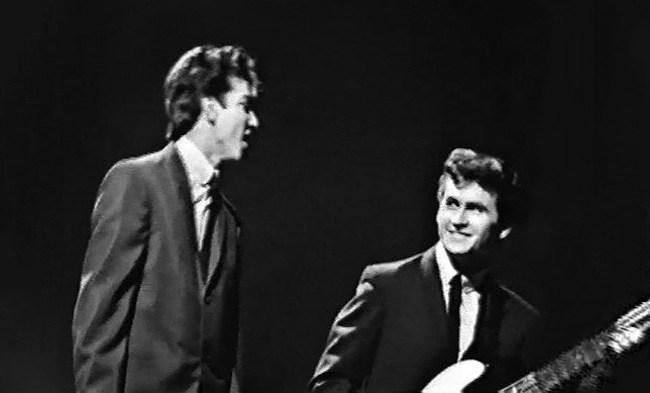
Ray Van Ross and Vic Jones appear on Club 7 Teen with the group called Thorts in 1965
Thorts on ‘Club 7 Teen’ in 1965 – “Bumble Bee”
WA TV History
The ‘Thorts’ which made a number of appearances on Club 7 Teen, then directed by Gordon McColl. A show that Vic was often the audio operator for.
Thorts on ‘Club 7 Teen’ in 1965 – “I Want You For My woman.”
WA TV History
The ‘Thorts’ which made a number of appearances on Club 7 Teen, then directed by Gordon McColl. A show that Vic was often the audio operator for.
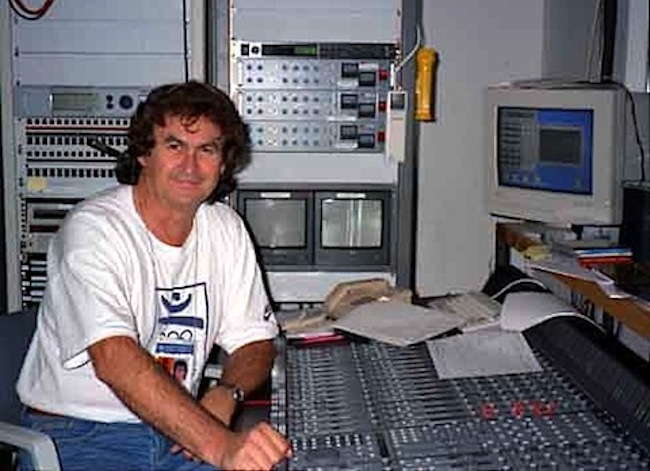
1992 Barcelona Olympics – Vic Jones, Audio Director
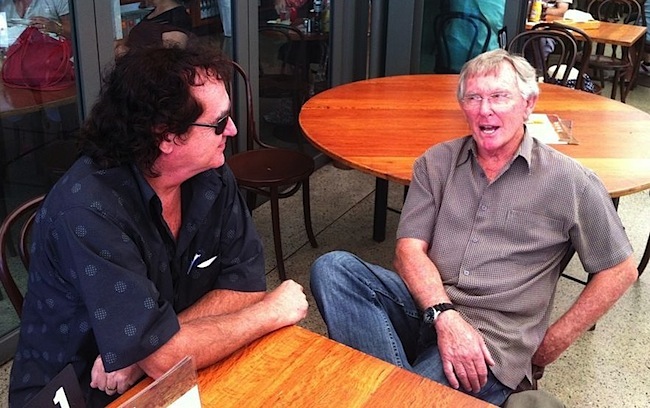
Vic Jones and Max Taylor in 2012
Peter Hobson worked in Engineering from 1962 to 1990. Peter Joined TVW the year videotape technology was introduced to the station with two RCA TRT-IB predominantly valve two inch quadraplex videotape machines. Recording and replay operations were an integral part of a technician’s role in those early days, until the creation of the Operations Department when some staff concentrated on the operational component of the station, whilst others specialised in equipment installation and maintenance.
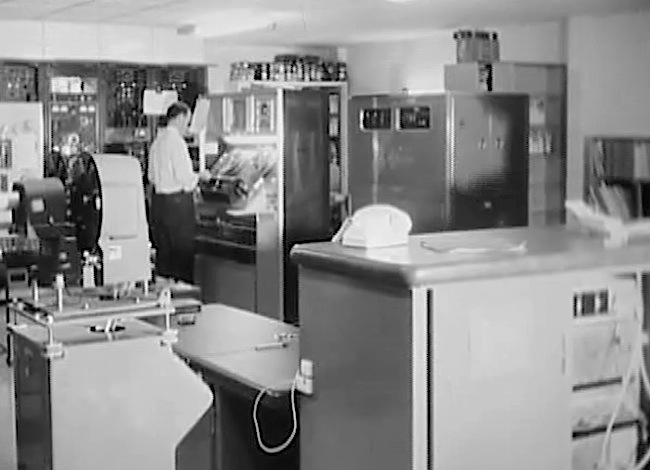
The above photo was taken in 1968, shortly after all the presentation orientated operational equipment was relocated in a building extension, in preparation for colour and semi-automated presentation. In the rear left can be seen one of the low-band TRT-IB black and white videotape machines, purchased for the Commonwealth Games in 1962. A 35mm slide projector can be seen on the left, which was part of a PYE black and white telecine chain, dating back to the station opening in 1959. To the rear of the photo can be seen the box shaped caption scanner which contained the station clock, two magazines of cardboard caption cards, and the scroll used for closing credits. This dates back to when all artwork was done by hand using ink and paints. The caption scanner also doubled as a pie warmer.
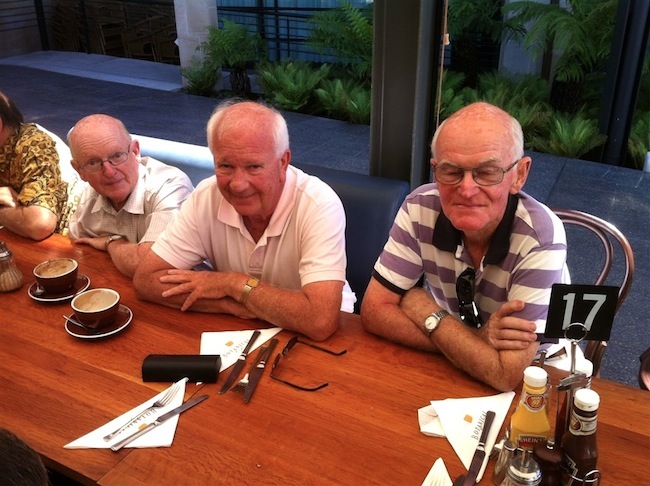
Kerry Cook worked first in Audio until becoming a shift supervisor in Master Control from 1960 to 1971. It was Kerry who designed and built TVW’s first cueing system. Prior to this device, staff had to use a stop watch and keep an eye on the clock, or rely on verbal cues coming from telecine or videotape, as to when a commercial break was due. Kerry’s unit employed silver tape on film and tone cues on the videotape cue track to trigger a visual countdown with audible alerts to herald each break. Kerry eventually continued his career at ABW Channel 2, working in most areas associated with TV presentation.
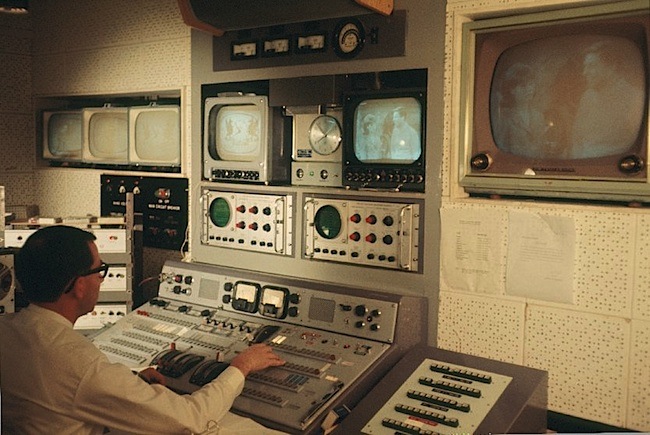
Kerry Cook in TVW’s original Master Control during 1960s
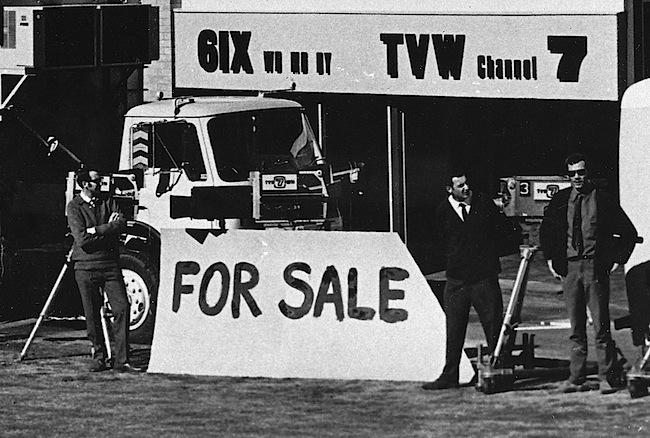
Kerry Cook, Hymie Miller and Peter Partridge joke about selling the new OB van in the 1970s
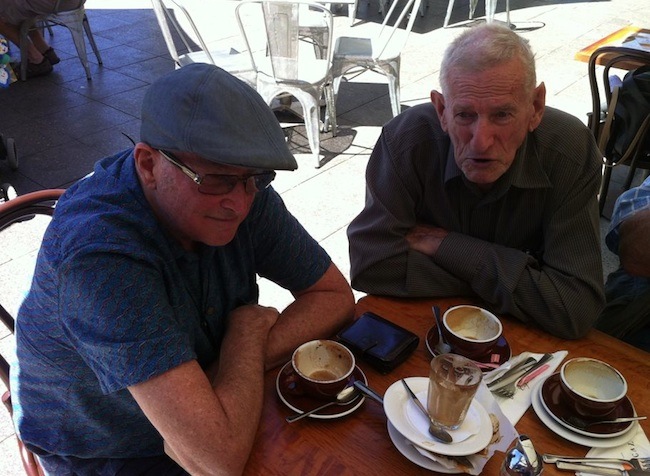
Kerry Cook and Bert King in Kings Park 2012
John Morcombe was a Videotape and Telecine operator then OB operator from 1970 to 1972.
Not only did John work in the videotape and telecine areas of TVW, but also spent a period operating the TV facilities at Goldsworthy, which also included a technical component keeping all the equipment working. John moved to the ABC and gained qualifications as an Engineer, where he went on to design and program clever devices in radio and was their D-Cart expert… when the ABC’s design laboratory came up with one of the very first networked digital audio recording, editing and distribution systems.
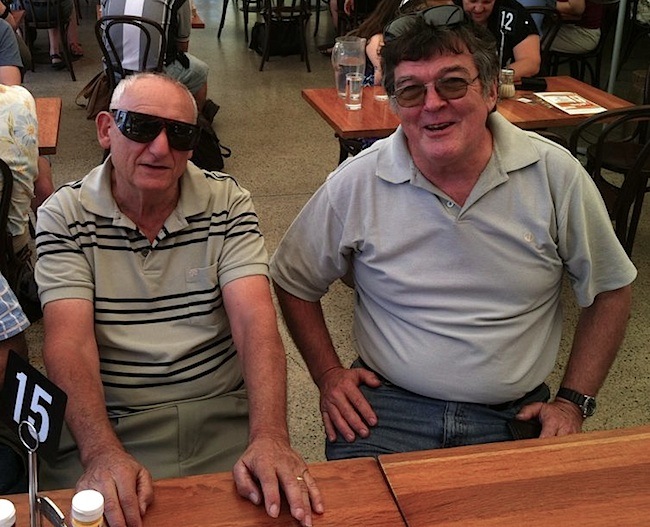
Hymie Miller and John Morcombe in 2012
Cedric Woods was a Technician Grade A at the TVW Transmitters, then a Senior Technical Director in the studios from 1961 till moving to STW in 1965.
Cedric was STW studio supervisor from 1965 to 1967, and largely responsible for the initial studio installation and equipment commissioning before the station opening and then performed ongoing maintenance until joining the Mount Lawley Technical College as an instructor in radio and TV trades. Whilst there, Cedric worked though the various grades of lecturer in engineering, followed by the senior lecturer in broadcasting, communications and television. Cedric gained a degree in engineering and bachelor of education before becoming the head of the department. Then became superintendent of engineering and computers. Cedric later became a consultant working on the City of Perth closed circuit surveillance system. Following this he became the head of research and development with Ultrak of America, with the opportunity to travel the world. Later, Cedric came out of retirement to tutor in communications for the navy.
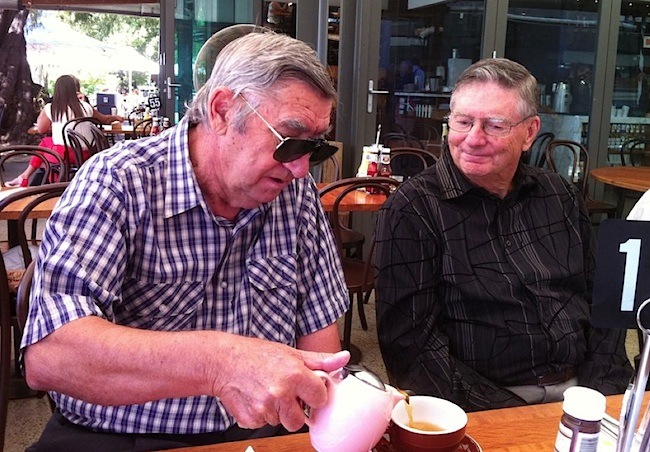
Cedric Woods and Kevin Bicknell in 2012
Max Taylor’s profession is in the electrical trades and as thus worked in studio Lighting from 1965 to 1974.
Max joined Seven at a time when there was a big exodus of staff to STW9 for its start up. Among those leaving were Cedric Woods and Bob Penno, who were present at the Kings Park Gathering. Two former electricians who helped build the station before moving into Engineering and operations work were George Baker and Colin Gorey who unfortunately missed the get together. Colin is a great friend of Max’s brother and both were involved in the Canning Volunteer Fire Brigade. Their fathers were also close friends and fought together during the war. Other noted electricians were John Butt, John Busher and Lindsay Smith. Lindsay was also present at this gathering, though sadly the well liked John Butt and John Busher are no longer with us. John Butt went onto being a qualified technician, telecine and Master Control operator before Technical Directing and sorting out the staff rostering and facilities use. John Busher was a studio lighting man. Max gained qualifications as an electrician and when George Baker, Colin Gorey and John Busher moved to STW in 1965, Max joined Seven in the lighting section and performed much of the electrical work. Later Max started his own electrical contracting business, after gaining further qualifications at night school, and ran that for 20 year before selling it and then working for the City of Perth for 17 years.
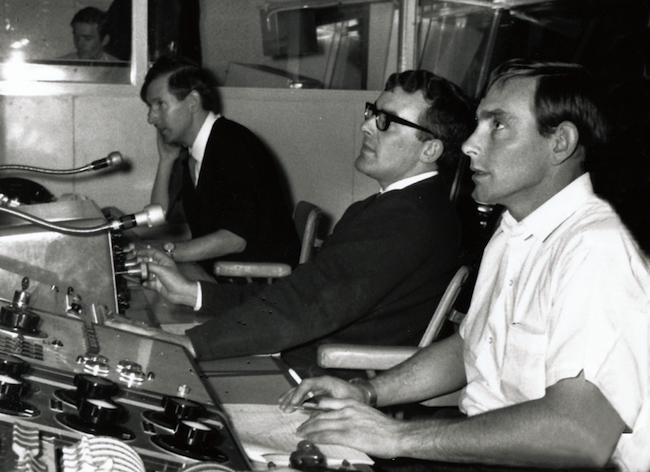
Terry Green (Audio), Keith Mackenzie (Director), Gerry Swift (Technical Director) and Max Taylor (Lighting) in VMU1 for In Perth Tonight during the late 1960s
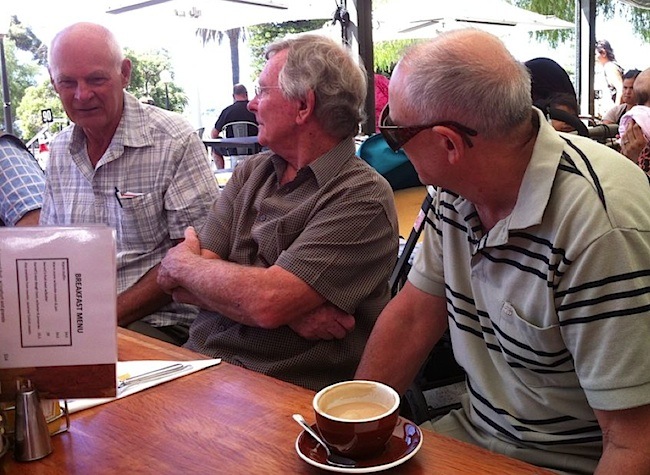
Geoff Mortlock, Max Taylor and Hymie Miller in 2012
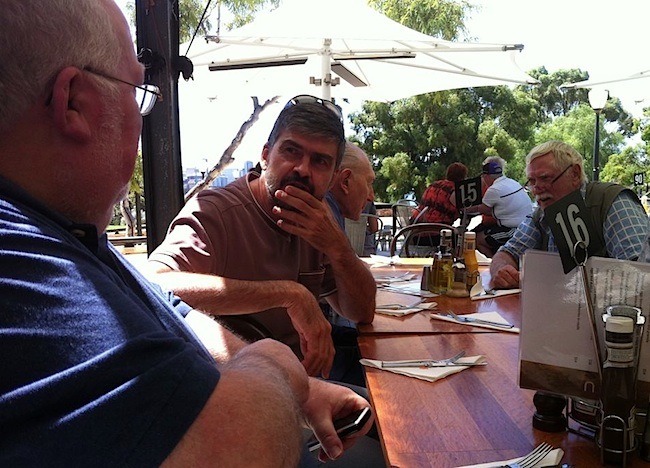
Peter Croft, Danny Piccin, Phil Salinger and Gordon McColl in 2012
Danny Piccin worked for Engineer from 1985 to 1989.
Keith Spice worked at TVW from 1970 to 1989 before transferring to Seven Network’s operations in Sydney.
Keith is a Scarborough lad who won a Commonwealth Technical Scholarship at Scarborough Senior High School in 1965, completed a one-year full time Pre-Apprenticeship course in Radio & Television Servicing at Mount Lawley Technical College in 1966 under the tutorage and guidance of a young Cedric Woods, and served his apprenticeship from 1967-1969 with Anthony Michaels Pty Ltd in Perth.
He applied to join TVW Channel Seven in 1970 (was interviewed and employed by Seven’s Chief Engineer John Quicke) specifically to manage the shared TVW/STW closed circuit television facilities at Mount Goldsworthy for 6-months, and on his return joined TVW’s Outside Broadcast Department reporting to OB Supervisor Vic Kitney.
Keith was transferred to TVW’s Videotape Department in 1972, became Videotape Supervisor in 1976, and Operations Manager in 1979, following in the footsteps of Kevin Campbell’s identical career progression path to that point in time.
Transferred to Sydney in 1989 as the Seven Network’s Broadcast Operations Manager, he became Production & Operations Director of ATN Channel 7 Sydney in 1990, and was appointed to the Seven Network Olympic Unit in 1998 as Head of Olympic Production Planning and On-Site Operations.
He was invited to join Global Television Pty Ltd as their Senior Executive Manager in 1999, and was appointed Chief Operating Officer of Global Television in March 2000. He retired in December 2003 and returned to WA in August 2005.
Keith lives in Mandurah with his wife Anne, and is an active member and Past President of the Port Bouvard Pistol & Small Bore Rifle Club.
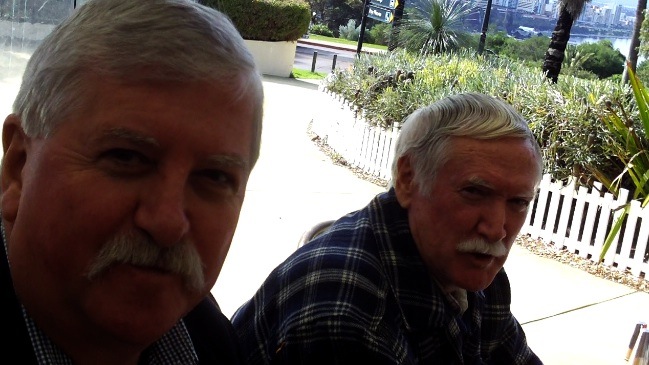
Keith Spice and Gordon McColl in Kings Park
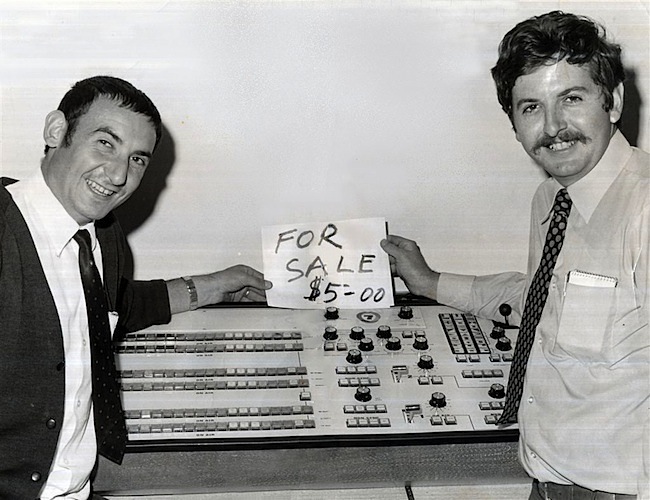
Hymie Miller and Keith Spice offering to sell F.R.E.D. in the 1970’s
Hymie Miller has participated in a most varied career from early sales experience, which possibly contributed to his amusing attempts to sell various bits of TVW infrastructure, to an active involvement in the education field, in later years. From 1959 to 1961 he enjoyed a variety of employment opportunities that included Pharmacy Apprentice, Bairds Hardware sales, Boddington Farm Hand, Encyclopaedia Sales, Simms Metal Labouring & Boans Fabric Sales. In 1962 Hymie joined the Electrical Engineering Department of UWA as a Laboratory Assistant and was later employed as a Technician.
In 1969 Hymie was fortunate enough to secure employment with TVW Channel 7 as a Senior Technician.
It was 4 years later in 1973 when he accepted the challenging position of Assistant Engineer at STW Channel 9.
The hunt for people who could lecture in Colour Television saw Hymie join the TAFE system in 1975, where he lectured in over 40 different subjects of the Certificates & Diplomas in Electronic Engineering firstly on the Mt Lawley Campus and later at Carine.
Hymie also lectured part time at Curtin in Educational Technology.
After pulling the pin in 2000, he have spent the freedom years enjoying a variety of tasks as a Handyman.
Hymie Miller Remembers:
- I remember Jim Cruthers telling me when I shifted employment from 7 to 9 that “the door is always open” and that he wished me well.
- I remember climbing the steel ladder on the outside of the building to reach the wooden platform so that we could haul up the Microwave Links to receive live OB’s. It was a petrifying experience and I later learned that I had a condition known as Benign Positional Vertigo.
- I remember once when the main links to the transmitter failed Geoff Mortlock had me holding some patched together microwave detector in front of the dishes to confirm the signal was “OK leaving this end”.
- I remember early morning start ups, going around the racks tapping heated valves, testing for micro phonics.
- I remember during the period of the Moon landings we used to rig Microwave links from OTC up the road back to the station & then have to de-rig for use at the speedway or the trots etc.
One day Geoff had a brain wave & invented a booster amplifier that we fitted in line between two 100 metre cables that we could role out and stretch across the road between OTC & Master Control. One lazy Sunday morning shift I grabbed a length of piping and, using a fire hose, managed to illegally shove the cable under the roadway so that we just had to fling it over the fence at OTC when we wanted a feed. - I remember receiving mild concussion after being whacked in the head by a 50 mm diameter brass fitting on the end of a link cable swinging down the side of a city building.
- I remember, also on a weekend duty shift, (not long after a group of us passed the C class driving test by driving around the block at Midland) taking the new articulated semitrailer OB van for a bit of a spin. As I headed down the rather short steep hill towards Gay St I lost the down shift through the 17 gears and came screaming down the hill with trailer brakes locked, pumping cabin brakes like crazy. With the half a million dollars worth of equipment on board I managed to round the corner with not all wheels touching the ground. It was a very nervous trip back to the OB bay.
- I remember conversations in the workshop hideaway with a young Brian Bourke expressing his contempt for the then political leaders of the day. He called them all some pretty bad names.
- I remember manufacturing a mechanical revolving Channel 7 logo that we put in front of a slide projector camera.
- I remember Albert Pressland as a secretive monitor genius.
- I remember early morning kids shows with Jenny (Clem) Clemeshia.
- I remember a storeman who thought that every item of equipment he handed over was his own personal property.
- I remember it is time to stop remembering.
Photos courtesy of Keith Spice, Peter Croft, Kerry Cook, Mike Humphry and Channel Seven.








Hi Ken,
I realise this is not the right place to post my message but your “contact us” page does not seem to have a button which allows the message to be sent, hence I am using this page.
My reason for writing is that in late-1966/early-1967 I was the engineer responsible for acceptance testing of the OTC(A) Carnarvon Earth Station as part of the acceptance from the US contractors. As a result, I was very much involved in arranging the Carnarvon-Goonhilly TV transmission in November 1966. Recently, I have set down my recollections of this period and collected all the photos and I would like to send you a copy if this is of interest. If you could provide me an e-mail address, I will forward the article and the photos.
Regards,
Guntis Berzins
Hi i see this all about Engineering Reunion and i was working in Ch9 back 1991 to 1993 and i like to know what happen to Gus Slater, i was good friends with him, he was like a father to me, and was good friends with Bob Penno as we all did Hma Radio together is there any way to contact Bob now?
Hi there.. I have been informed that this Max Taylor in this article may be my grandfather! Can someone with information please contact me?? Maxinetaylor90@gmail